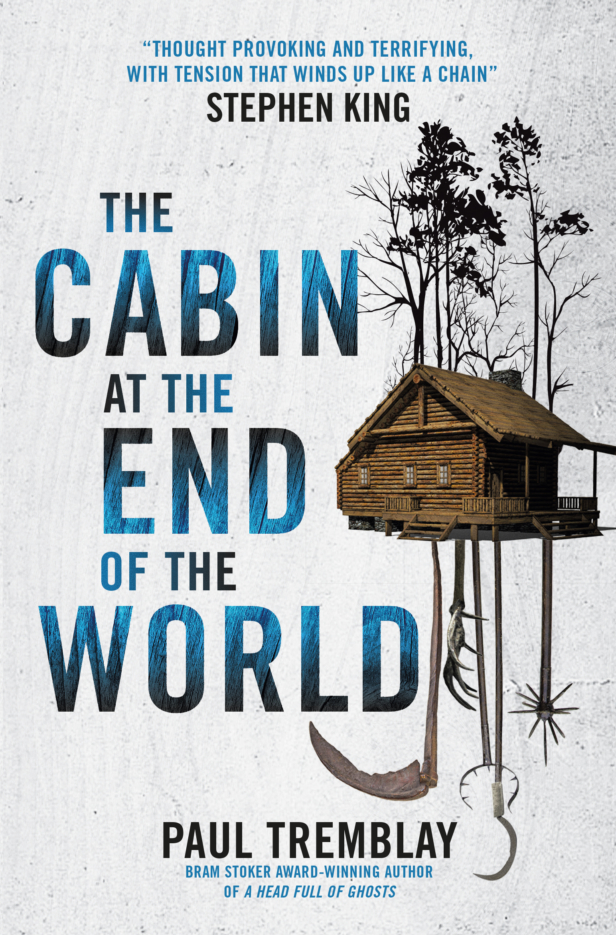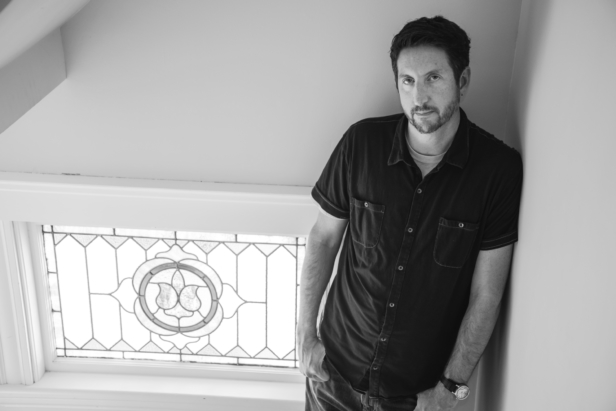Everyone loves a good hypothetical. Would you do a truly awful thing if it meant saving someone’s life? In The Cabin At The End Of The World, A Head Full Of Ghosts and Disappearance At Devil’s Rock author Paul Tremblay twists a classic home invasion opening into a nightmarish and much broader scenario, all within the confines of a single holiday home. Four strangers tie up Andrew, Eric and their daughter Wen and tell them that one needs to kill another, or the world will end. The longer they delay, the more earth-shattering events will occur until it’s finally too late.
The post-apocalypse is obviously a very popular setting in genre fiction but the knife-edge before it happens doesn’t seem to come around too often! Was the possibility of the end of the world the starting point for the idea?
The idea for The Cabin At The End Of The World started with my drawing, well, a cabin in one of my ‘idea’ notebooks. It was something I doodled unconsciously, but when I saw my little cabin I thought about the ‘home invasion’ subgenre of horror. It’s my least favourite subgenre, which, ultimately, was the motivation behind writing the book. I was excited by the challenge of writing a home invasion story that I would want to read.
I thought the possibility of an apocalypse mixed with the home invasion story would be an interesting way to raise the stakes beyond the personal. That knife-edge of pre-apocalypse you described has long been a fear of mine. As a child of the Cold War 1980s, I’ve long feared civilisation’s sudden and violent end. Many of my earliest short stories featured our imagined end and a few even described ambiguous scenarios that may or may not have been precursors to an apocalypse.
Did you always know that it would take place over a very brief span of time and essentially in one setting?
Yes, once I had the skeleton of the story in place, I knew Cabin would have to be a short (both in terms of timeline within the plot and number of pages written) and intense book. I’m not a playwright by any stretch, but I wrote the novel with a mindset that this story could be intimate enough to be performed on a stage.
What was the process like of fitting a story into those constraints?
The dichotomy of the wide expanse of the surrounding lake and forest with almost all the action taking place within the claustrophobic cabin made for a great source of tension. That feeling of isolation one gets when out in the wilderness can be both terrifying and thrilling. In a way, that feeling of anything-could-happen-and-no-one-would-know is part of the reason so many of us seek out wooded/wild spaces. That the small cabin might contain a larger (larger in terms of wider implications beyond the people in the cabin) struggle was part of the story’s appeal for me.
There isn’t a ton of plot to the story so I was forced to make sure I did proper work in building (hopefully) empathic and authentic characters, as they would have to carry the novel. Using multiple points of views helped, I think, in creating a tone of unease and ambiguity as some of the characters experience the events of the novel differently.
Ambiguity and unreliability were big factors in A Head Full Of Ghosts, are they elements that you enjoy playing with?
Ambiguity and unreliability are wonderful fodder for a horror story. Or any story for that matter. Memory, identity, even reality are a lot more malleable than we like to believe. Existence is rooted in personal and existential ambiguity. So many of my favourite works of literature are about the unsure footing of our daily lives.
How do we live through this? How does anyone live through this? I think horror can really dig at those questions in inventive and meaningful ways.
We don’t really get a window into the captors’ heads until the final third. Did they evolve over time or did you always know that they were going to have to be “reasonable”?
Yes, very early in on in the process I knew that my invaders wouldn’t be emotionless monsters. I wanted them to be as recognisable as the protagonists.
There’s no one correct way to write a horror story, obviously, but more often than not I find approaching all the characters, including the villains or the characters who do horrible things, from a starting point of empathy is an effective way to build dread and create the effect of horror. Again, there are no absolutes, but I generally find the characters who do terrible things yet seem reasonable (or believe that they are reasonable) are scarier than faceless, implacable villains.
With Cabin, I thought what most of the strangers were going through (without getting too spoilery) was a horror and worth exploring. I did want the tension of having these people who view themselves as good, as ‘everyday people,’ (with that statement being loaded with as much baggage as possible) feeling like they had no choice but to participate in such an obviously wrong or immoral event. The idea of truly believing one has no choice in what one is doing (or is about to do) is a horror, and a terrifying one at that.
One of the key points is that Andrew is never going to believe the group, and the group is (pretty much) unwavering in their belief… Is a lack of communication between different groups something that scares you in real life?
With A Head Full Of Ghosts and The Cabin At The End Of The World, I attempted to build ambiguity by throwing a glut of data at the reader instead of solely relying upon unanswered questions and loose ends. In both books you are bombarded with compelling evidence on both sides of the supernatural/non-supernatural argument. Hopefully the result is that the reader might be more closely in tune with the uncertainty the characters would be feeling. I hope it works as a purposeful reflection of the daily dread and anxiety of our age of misinformation.
On a similar note, to what extent are you thinking about social commentary and parallels with real-world events and current fears when you’re writing a story like this?
Ever story is different for me. More times than not subtext or underlying themes form organically. Or maybe a better way of saying it is that I’m usually discovering what a story is about as I’m writing it.
However with Cabin the subtext was there from page one. I wrote fifty pages and a plot summary during the 2016 United States presidential election season. I wrote the rest of the book in the election’s aftermath. My goal was for Cabin to be a horror/suspense novel, but one that also (without getting too didactic) worked as an allegory for our current socio-political anxieties.
How much of the story and structure for this novel did you have planned out before you started?
I wrote a 10-15 page plot summary by necessity. A Head Full Of Ghosts and Disappearance At Devil’s Rock fulfilled my two book deals with both my US and UK publishers. In order to get back within the warm embrace of my publishers (er, to get another book deal) I needed to submit 50 pages and a plot summary. So I did.
Normally, I try to approach all aspects of a novel with the mantra of what-serves-the-story-best in mind, and I extend that to whether or not I write an outline beforehand. For novels that have more of a mystery structure (I’m not good enough at plot to make up a mystery as I go), I outline. I have written novels without an outline and A Head Full Of Ghosts was one of them. The Cabin At The End Of The World felt to me like a book that didn’t need or warrant a summary, and I wanted a less structured, chaotic/anything could happen feel seeping into the DNA of the book. But as I said above, I had to write a summary for my editor. I’ll admit to writing a half-assed (or 2/3rds assed) summary and I left the ending open with something cheeky like “Is ____ going to happen at the end, or _____? I have to write the book to find out.”
I usually know the beginning and end of my books, with or without an outline, before I start. And then the puzzle is getting from point A to point Z. My vision of Cabin’s end changed after writing the 50 pages and the summary, though.
How excited are you about the upcoming film adaptations of your work?
Very excited! As someone who is fascinated by influence and telling stories in slightly different or skewed ways, I really can’t wait to see how my stories are filtered through a filmmaker’s lens. Both A Head Full Of Ghosts and The Cabin At The End Of The World have had super talented and friendly (they talk to me!) screenwriters working on the adaptations. And I love the films (February/The Blackcoat’s Daughter and I Am the Pretty Thing That Lives In The House) of director Osgood Perkins, who has been hired to direct A Head Full Of Ghosts. I’m honoured and hopeful we’ll see one if not both on the screen someday. Knock on wood. All the wood.
Do you remember what your first encounter with the horror genre was?
Growing up outside of Boston in the days before cable TV (a dark, terrifying age, I know), there was a local program that ran on Saturday afternoons called Creature Double Feature. The first film was generally a Kaiju film (which I adored) and the second film was either a Hammer production or a black and white, 1950’s or 1960’s exploitation flick. The second movie always scared the hell out of me. One of my old favourites from those Creature Double Feature days was Quatermass And The Pit (or, as it was called in the US, Five Million Years To Earth). I used to have dreams/nightmares featuring the giant, glowy alien head from the end of that movie. That movie still holds up quite well. I’d love to see it rediscovered by modern audiences.
Which authors are you particularly excited about at the moment?
Here’s a brief list, in no particular order, of some of my favourite works of horror in recent years:
John Langan’s The Fisherman, Laird Barron’s Occultation (short story collection), Livia Llewellyn’s Furnace (collection), Adam Nevill’s The House Of Small Shadows, Nadia Bulkin’s Bhe Said Destroy (collection), Nathan Ballingrud’s The Visible Filth (novella), Victor LaValle’s The Changeling, Marina Enriquez’s Things We Lost In The Fire (collection).
What’s coming up next?
Next summer my short story collection Growing Things And Other Stories will be published in the US and UK. Four of the nineteen stories have connections to the novels A Head Full Of Ghosts and Disappearance At Devil’s Rock, including an original novella and a story featuring Merry from A Head Full of Ghosts after all of the events detailed in the novel.
The Cabin At The End Of The World is available now from Titan Books.

